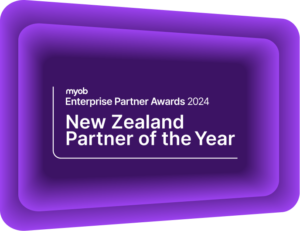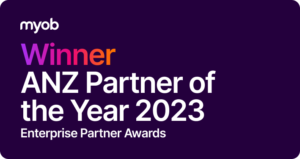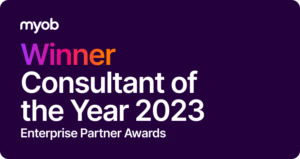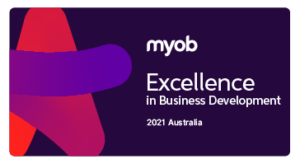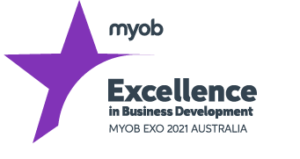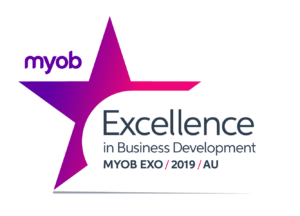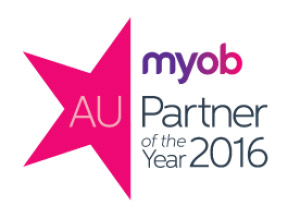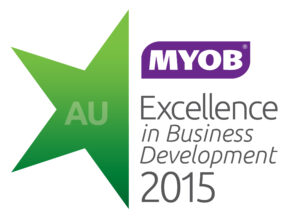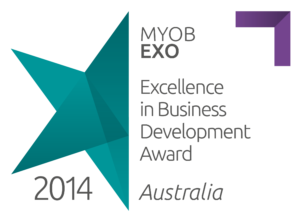Major risk factors CEOs and CFOs must manage in an ERP implementation
Managing risk is the key to the success of any project.Implementing an Enterprise Resource Planning (ERP) software system is a significant undertaking for any organisation. Business management platforms like MYOB Advanced (Acumatica) and MYOB Exo integrate processes and functions across your organisation. When properly configured, an ERP system can streamline processes, reduce time wasted on manual tasks, and provide valuable insights for improved decision-making. That said, the journey to successful ERP implementation is not without its challenges.
Why should CFOs and CEOs act to implement a new ERP system?
Investing in digital technologies is crucial when improving efficiency and transforming your organisation. Real-time data visibility is a key benefit of cloud-based ERP systems. Having the right data at your fingertips helps you to make earlier, more informed decisions, guiding your organisation to successful outcomes. Powerful technologies such as cloud and hybrid-cloud computing, AI, and machine learning mean that today’s finance leaders can utilise their multiple systems and analyse thousands of data points in near real-time, identifying trends and deviations with more speed and accuracy.
According to Forbes, EY, Deloitte, and Raconteur, investing in technology should be the top priority of CEOs and CFOs. More than 70% of CFOs recognise the need to invest in smart digital transformation, with 37% aiming to accomplish this in the next three years.
Traditional CFOs operate by looking backwards, analysing historical data, and using that to project to the future. Technology solutions that promote forecasting are essential when looking for ways to stand apart from the competition and plan strategically. These systems then become a major asset to a company. Implementing MYOB Advanced Business (Acumatica) and MYOB Advanced Payroll has liberated companies like Revelop to concentrate on more strategic initiatives.
CFOs and CEOs can access a wealth of data in an ERP system that covers more than just financials. Data analytics gives you the power to explore new ways to improve efficiency across the entire organisation. Implementing an ERP system to facilitate this data visibility is what elevates CEOs and CFOs to the role of strategic advisors for their teams. Choosing the right software and software implementation partner is crucial to you and your business’ success.
What can go wrong in an implementation?
A failed ERP implementation can result in financial losses, decreased productivity, low team morale and damage to your organisation’s reputation. For CEOs and CFOs, this could also cause irreparable damage to their career.
A poor implementation will leave you saying things such as:
- “This is worse than what we had before.”
- “This is harder than what we were expecting. I did not realise I would be required to…”
- “I hate this system, but we spent so much money and have to live with it.”
- “We should avoid throwing good money after bad.”
- “I am sure the software is good, but something is not right, and the implementers cannot seem to be able to fix it”
- “This is not what we thought we were getting.”
- “Surely the system can do this – it is so simple – there must be a hundred companies that do this as we do.”
Understanding and managing risk in an ERP implementation
ERP implementations fail or hit turbulence when both the client and implementer fail to properly understand each other, and manage risk.
Business management platforms are complex, much more so than simple “off-the-shelf” accounting systems. You must undertake a thorough and dedicated implementation project to set your organisation up for success in your new system. Engage the services of a trusted, expert implementation partner so that they can use their skills and experience to guide you to success.
An ERP system is not always the solution to inefficiency problems. Simply swapping one ERP system for another will provide no efficiency improvements and is not a sensible investment. This is why choosing an implementation partner with the skills to properly implement a solution, as well as the knowledge and experience to bring overall Business Process Improvement, is so important. Take careful consideration of your business processes and consult an expert before signing the dotted line on a costly implementation project.
Any software implementation comes with inherent risks:
- Software risk – will the new system do what we need it to do?
- Implementer risk – does the implementing team have the skills required to fulfil the sales team’s promise and unlock the potential of the software?
- Self-inflicted risk – can your own team devote the appropriate resources to the implementation?
Like any complex project, it is far better to do it once and do it right. Money and time spent on rectification far exceed the cost of doing it right the first time. A successful MYOB Advanced implementation is very rewarding in the end, but there is some pain to endure to get through it. Typically, client satisfaction or dissatisfaction changes over time. This is closely related to the stage of the implementation.
What are the major risk factors for a CEO or CFO?
It is important to note that every organisation is unique, and the specific risk factors and challenges may vary. However, by understanding common risk factors, organisations can proactively identify potential pitfalls and take appropriate measures to minimise their impact.
Lack of Proper Planning
Risk Type: Implementer Risk, Self-Inflicted Risk
Failing to invest sufficient time and effort into the planning phase can lead to complications and setbacks during the implementation process. Organisations often underestimate the complexity of their processes and fail to capture all the necessary functional and technical requirements they will need in the ERP system. The result is a misalignment between what the software is configured to do and your actual needs. Without a clear understanding of the project’s boundaries, organisations are at risk of scope creep, where the project expands beyond the initial objectives, resulting in increased costs, delays, and compromised quality.
As new requirements emerge or stakeholders request additional features, there is a tendency to accommodate these changes without thoroughly assessing their implications on the project timeline, resources, and budget. An implementation plan serves as a guiding document, providing a structured approach to the entire process and ensuring that all key tasks and milestones are accounted for.
How to mitigate the risks of poor planning
- Conduct thorough interviews with stakeholders and teams across your organisation.
- Carefully analyse existing workflows and document all critical requirements.
- Identify core functionalities and deliverables – must-haves for when your system goes live.
- Follow a structured methodology and the guidance of a trusted and experienced implementation partner.
- Budget for the entire cost of the implementation plus contingencies beforehand.
The best strategy to budget for an implementation
Have open and honest conversations with your potential implementation partner about your budget. ERP implementations can be a significant investment. You are paying for the total customisation of the new system so that it can meet your unique requirements now and in the future. Rushing through an implementation with an improper budget will cost you more in the long run. You do not want to risk running out of budget part-way through the implementation or attempting to go live quickly, having to pay to optimise the system later on. Budget and prepare appropriately to see a successful outcome. The skills and experience of the implementation partner will also affect the final cost. Again, engaging a premium implementer will pay dividends in the long run. With less experienced partners, you are likely paying for their implementation training, opening yourself up to excess and unnecessary risk. Getting your MYOB ERP implementation right the first time and reducing the risk of a failed implementation will set your organisation up for success.
Data Migration Challenges
Risk Type: Software Risk, Implementer Risk, Self-Inflicted Risk
Successful data migration means that you go live in your new system with legacy data in place. Data migration can pose several challenges and risks that need to be carefully addressed to ensure a successful implementation. Inaccurate or inadequate data leads to incorrect reporting, compromised decision-making, and operational inefficiencies.
Over time, organisations accumulate vast amounts of data in their legacy systems. Multiple systems, databases, and file formats are also common. It can be challenging to harmonise and consolidate the data within the new business management platform. Migrating sensitive and confidential data to a new system requires robust measures to safeguard information from unauthorised access, breaches, or data loss.
How to mitigate the risks of data migration
- Invest in data cleansing and validation activities before the migration process. Identify and rectify data inconsistencies, remove duplicate records, and verify the integrity of critical data. The more of this you can do yourself, the larger the cost saving.
- Establish data governance policies and procedures to maintain long-term data accuracy.
- Choose a partner with the accounting and technical skills to ensure you go live with correct, up-to-date, reconciled data.
- Make sure the new system prioritises security in the cloud by encrypting data and suppoting configurable role-based permissions.
Technical Issues and Integration Problems
Risk Type: Software Risk, Implementer Risk
Implementing a new business management system often involves integrating existing or new third-party systems and databases. Doing so creates a connected software ecosystem to manage your entire organisation from one platform.
Integration and automation are the keys to improving efficiency. Without a single, integrated source of truth, you will waste time manually duplicating data and stifle opportunities for efficiency improvement. Your new system should have the ability to integrate with best-of-breed third-party applications. This is commonly performed with an Application Programming Interface (API). Legacy systems or specialised departmental software may not be able to integrate with your new ERP system. Insufficient hardware capabilities, an outdated network infrastructure, or inadequate IT resources can result in performance issues, system downtime, and poor user experience.
How to mitigate the risks of integration
- Choose a system with an open API. These systems can integrate with a wide array of third-party products.
- Conduct a thorough evaluation of your current processes and systems. The functionality of a third-party application may be possible to replicate in your new ERP system.
- Engage a trusted, expert partner with the technical skills to integrate your new system with your third-party software ecosystem.
- Cloud-based systems avoid the risk of hardware and IT support. They are hosted on offsite servers that are managed by the hosting provider and vendor.
Vendor-related risks
Risk Type: Software Risk, Implementer Risk
The reliability and expertise of the vendor is incredibly important when choosing a new ERP system. The vendor should have an innate understanding of the business requirements in your particular vertical, local business conventions, terminology, and local legislative and compliance requirements.
The role of the vendor is critical in software support. Inadequate vendor support can lead to delays in issue resolution, unaddressed system errors, and limited assistance during critical stages of the implementation. There is also a risk that less established vendors might disappear from the market, removing options for support, development, or security updates. Offshore vendors are less likely to understand and cater for your specific local compliance requirements. These requirements will likely need to be developed by your implementer at an additional cost if they can even be included in the system at all.
How to mitigate vendor risks in an implementation
- Choose software from a local vendor. These vendors are better able to understand your organisation’s needs and compliance requirements.
- Make sure to consider the lifetime of the vendor in a market. Established, experienced vendors with many users bring much less risk to your software selection.
- Evaluate the vendor’s reputation, software testimonials, and track record.
- Choose a skilled business partner that can offer post-implementation support independent of the software vendor.
- Be aware of time–zone differences where vendor support is required to resolve critical bugs.
- Vendor or implementation partners that offer an online support portal boast improved visibility and case resolution.
Insufficient User Engagement and Training
Risk Type: Implementer Risk, Self-Inflicted Risk
User engagement and training are crucial factors that lead to user adoption and proficiency with the new system.
If users feel excluded or uninformed about the changes brought by the ERP system, they may develop resistance or scepticism towards the new technology. If users are not adequately trained in the new system’s functionalities and processes, they may struggle to perform tasks efficiently. Some users may resist the new system due to concerns about job security, fear of the unknown, or a lack of understanding about the benefits it brings. This can hinder the adoption of the system, impacting the expected benefits.
How to mitigate the user engagement risks
- Search for an implementation partner that provides training as part of the implementation process,
- Lock in options for ongoing training and support, even after going live. New starters will need to be trained – it is best to be trained by the experts,
- Engage your team in the requirements-gathering process. Seek their feedback and involve them in system testing to foster a sense of ownership. This builds confidence in the new system.
- Hold regular training sessions and user workshops to enhance user engagement and promote a smooth transition to the ERP system.
- Clear and transparent communication about the reasons for implementing the ERP system, its benefits, and the support available for users can help alleviate resistance.
- Leverage “change champions”, your leadership team, and key influencers within the organisation to promote a positive attitude towards the change and encourage user buy-in.
Inadequate Project Management
Risk Type: Implementer Risk, Self-Inflicted Risk
Inadequate project management practices can lead to delays, budget overruns, and a failure to achieve the desired project objectives. An MYOB ERP implementation is a partnership; both the implementer and end-user must work together to follow the structured methodology and see a successful implementation. Without a clear understanding of who is responsible for what, tasks may fall through the cracks, accountability can be compromised, and the timeline will inevitably blow out.
How to mitigate the project management risks
- Appoint an internal “project champion” who is responsible for coordinating all teams involved in the implementation.
- Follow a structured methodology with an experienced implementation team.
- Plan the implementation beforehand – define project objectives, outline the project scope, estimate timelines and resource availability, and conduct a risk/benefit assessment.
- Establish regular project status meetings so that everyone involved in the implementation is on the right page.
- Utilise an online project management tool to improve communication within the teams.
The common thread for managing risk
By now, you may have noticed a common thread through all these risk factors – the implementer risk. Your implementation partner plays such an important role in your long-term software success. The choice of implementation partner is as important as the software itself.
7 points CEOs and CFOs should consider when choosing the right implementation partner
- Proven experience
- Structured implementation methodology
- Training and Support
- Accounting skills
- Strong relationship with the vendor
- Integration and customisation skills
- A large team of MYOB Consultants
Note that the cost, be it total cost or cost per hour, carries a relatively low weighting in terms of risk management. While competitors may undercut on hourly rates or total cost, this is an industry in which you truly get what you pay for. Lower cost correlates directly to higher risk.
Are you ready to take the next steps?
Consider a business management solution like MYOB Advanced (Acumatica) to combine your company data into a single source of truth and maintain your existing satellite products that have driven your success. MYOB Advanced (Acumatica) is a cloud-based enterprise resource planning (ERP) software developed by MYOB and powered by Acumatica – the world’s fastest-growing ERP system. It provides organisations with a comprehensive set of tools for financial management, supply chain management, project management, and more. The software is designed to streamline business processes, automate tasks and other business events, and provide real-time insights into key performance indicators (KPIs). It is suitable for large, complex organisations and can be customised to suit your specific requirements.
Is your organisation a good fit for MYOB Advanced?
MYOB Advanced (Acumatica) is a low-risk solution. Many satisfied companies have used it to improve efficiency. MYOB Advanced has powerful functionality to support organisations across a range of industries, such as construction, wholesale and distribution, not-for-profit, healthcare, government, financial services, education, multi-entity organisations, field services, professional services, engineering firms, manufacturing, project management and accounting, current Acumatica users, and more.
By partnering with Kilimanjaro Consulting and choosing MYOB Advanced (Acumatica) as your new ERP system, you control both the software and implementer risks of your implementation. Take your first steps towards a risk-free, successful future with your new MYOB Advanced (Acumatica) system.
The Kilimanjaro Consulting team build long-lasting partnerships with our clients. We are farmers, not hunters, and look to nurture our clients over their lifetime. To start a conversation about MYOB Advanced (Acumatica) and explore how it can improve efficiency in your organisation, email sales@kilimanjaro-consulting.com or call 1300 857 464 (AU) or 0080 436 774 (NZ).


